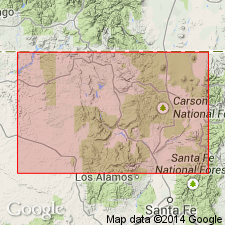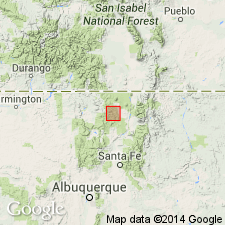
- Usage in publication:
-
- Tusas Mountain Granite*
- Modifications:
-
- Named
- Dominant lithology:
-
- Granite
- AAPG geologic province:
-
- Southern Rocky Mountain region
Summary:
Tusas Mountain Granite of Proterozoic Y (1,510-1,430 Ma Rb-Sr and U-Pb) age, named. Type area is shallow prospect pits, about 100 m west of road in NE1/4, sec 23, T28N, R7E, Rio Arriba Co, NM in the Southern Rocky Mountain region. Formerly included with Tres Piedras Granite by Just (1937), but that name restricted in this report to 1,700 Ma granite. Intrudes interlayered Precambrian metavolcanic and metasedimentary rocks and is covered locally by Tertiary conglomerate. Is a white to pink, fine-grained porphyritic granite.
Source: GNU records (USGS DDS-6; Denver GNULEX).

- Usage in publication:
-
- Tusas Mountain Granite*
- Modifications:
-
- Overview
- AAPG geologic province:
-
- Southern Rocky Mountain region
Summary:
Intruded metavolcanic and metasedimentary rocks of the Tusas Mountains, Rio Arriba Co, Southern Rocky Mountain region, assigned to Moppin Metavolcanics and Burned Mountain Metarhyolite (both revised and adopted) about 1,500 m.y. age. Age changed from Proterozoic X to Early Proterozoic.
Source: GNU records (USGS DDS-6; Denver GNULEX).
For more information, please contact Nancy Stamm, Geologic Names Committee Secretary.
Asterisk (*) indicates published by U.S. Geological Survey authors.
"No current usage" (†) implies that a name has been abandoned or has fallen into disuse. Former usage and, if known, replacement name given in parentheses ( ).
Slash (/) indicates name conflicts with nomenclatural guidelines (CSN, 1933; ACSN, 1961, 1970; NACSN, 1983, 2005, 2021). May be explained within brackets ([ ]).

